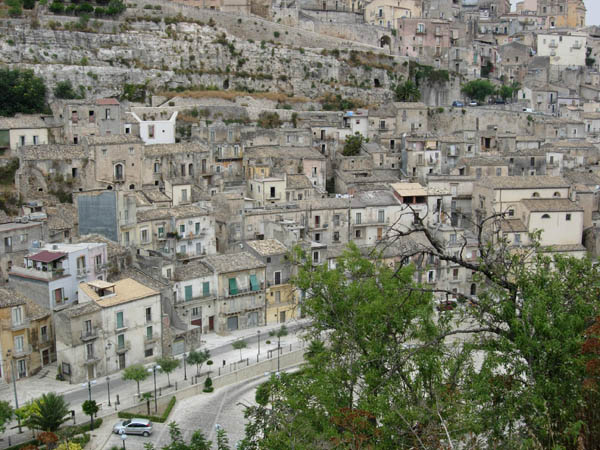Ragusa, and particularly its old town, called Ragusa Ibla, is another delightful Baroque town south of Syracuse, ideal place to spend a day among the wonders of the Sicilian Baroque and gastronomic delights.
The city can be reached easily from Syracuse in 1 hour by car (highway-Noto-Avola Rosolini, take the exit Rosolini follow signs for Ragusa) or train (1 hour and 50 minutes) or bus company AST (2 hours and 30 minutes). Trains and buses depart from the stations located 50 meters from the hostel.
UPPER RAGUSA: If we walk from Piazza della Libertà, where the railway station is located, we come to a building containing a hotel at the beginning of Ponte Nuovo (New Bridge): on one of the lower floors is the interesting Hyblean Archaeological Museum, with access from Via Natalelli. The museum is in six sections: Prehistoric section, Camarina, Sicel Archaic and Classical Towns, Hellenistic Towns, Late-Roman Settlements, and Purchases and Gifts. The material is arranged according to area of origin and in chronological order. Proceeding further, we come to the nearby Villa Margherita and, by way of Via Roma, to the Cathedral, dedicated to St John the Baptist: a stupendous construction initiated in the early years of the 18th century and completed in 1760. The façade is broad and low, and the interior is characterized by its smooth columns. Vertical pilaster strips diversify the chapter house abutting on the apse wall.
LOWER RAGUSA IBLA. Ibla can be easily reached by bus from the bus station or walking thorugh the pictoresque staircase (via delle Scale) Proceeding along Corso Italia, we come to Corso Mazzini, winding down and joining Ragusa Superiore to Ragusa Inferiore or Ibla, which can also be reached across three bridges (Vecchio or dei Cappuccini, Nuovo, and John XXIII) or by descending the hundreds of stairs of a long stairway, where it is possible to visit, on the boundary of the twin towns, the Church or Santa Maria delle Scale, built between the 15th and 16th century and rebuilt after 1694.
The church still contains some features of the original building, such as for example the three Gothic-Catalan portals in the right aisle and another refined and elegant Renaissance portal, in the last chapel in the same aisle. Further down through Ibla we come to Piazza della Repubblica which is dorninated by the Chiesa del Purgatorio, with a fine baroque portal in its façade. Proceeding from the Piazza down Salita Commendatore, we come to Palazzo Cosentini, built in typically exuberant baroque style, and the 18th century Palazzo della Cancelleria.
Here we can also see the Chiesa di Santa Maria dell'Itria, founded by the Knights of Malta in the 17th century It still has its original campanile covered with ceramics from Caltagirone. It contains a canvas attributed to Mattia Preti representing St Julian. Continuing along Via del Mercato or by other possible routes, we now come to the Chiesa di San Giorgio, built to the design of Rosario Gagliardi between 1739 and l77S. The fine façade is characterized by tiers of juxtaposed columns; its central part protrudes outwards and upwards. There are three paintings by Vito D'Anna, displaying good workmanship.
The Treasury contains various silver items of great value. Further along, and similar in shape to the Chiesa of San Giorgio although somewhat smaller, is the 18th century Chiesa di San Giuseppe, designed by an unknown architect. The internal plan is ellipticentury The church contains a 17th century silver statue of St Joseph. The nearby Norman Chiesa di Sant'Antonino presents its original Gothic portal in the façade; the sacristy portal is baroque. Going left, we can admire a fine 14th century portal in the Chiesa dell'Immacolata; while near the ancient walls, known as the Byzantine walls, is the Chiesa del Signore Trovato, rebuilt in the 18th and 19th century There is a fine painting of the Madonna del Carmine by Vito D'Anna in the Chiesa di Santa Maria di Valverde.
TheChiesa di San Giorgio Vecchio, in Piazza G. B. Odierna, is of considerable interest. This church has a reentrant façade and a splendid Gothic-Catalan portal, with an altorilievo on the lunette representing St George Killing the Dragon; above this are the Aragonese eagles. Now we come to the splendid Giardino Ibleo, laid out in the 19th century This garden offers a splendid panorama and views of three churches: the Cappuccini Vecchi, San Giacomo, and San Domenico or del Rosario. TheChiesa dei Cappuccini, modest in style, contains three paintings by Pietro Novelli (Assumption of the Virgin, Apparition of St Peter to St Agata in prison, Martyrdom of St Agnes). San Giacomo, built in the 14th century, was restructured in the 17th century The nave and two aisles w ere converted to a single central nave and the church took on a baroque air. The painted wooden ceiling is of 18th century.

